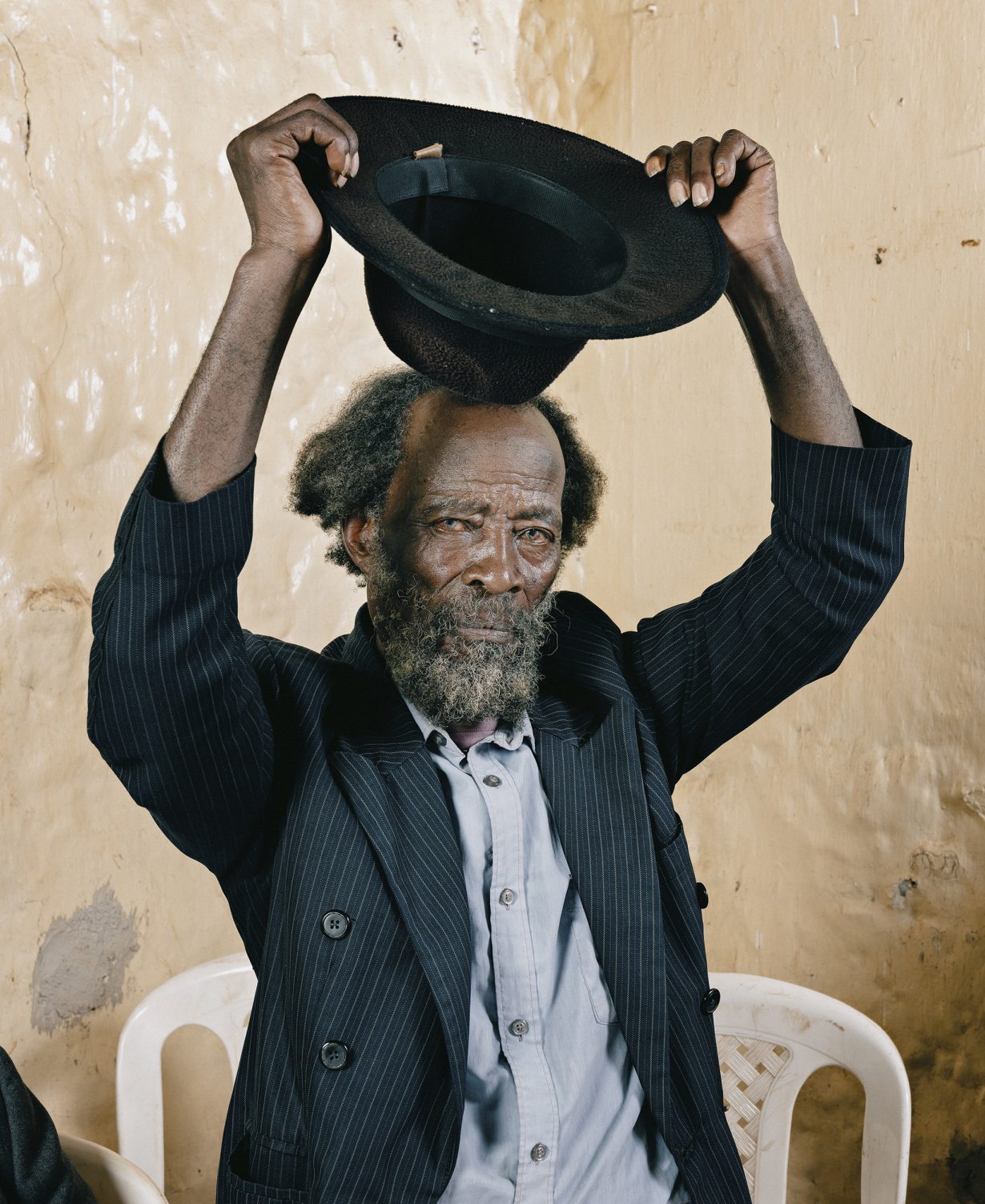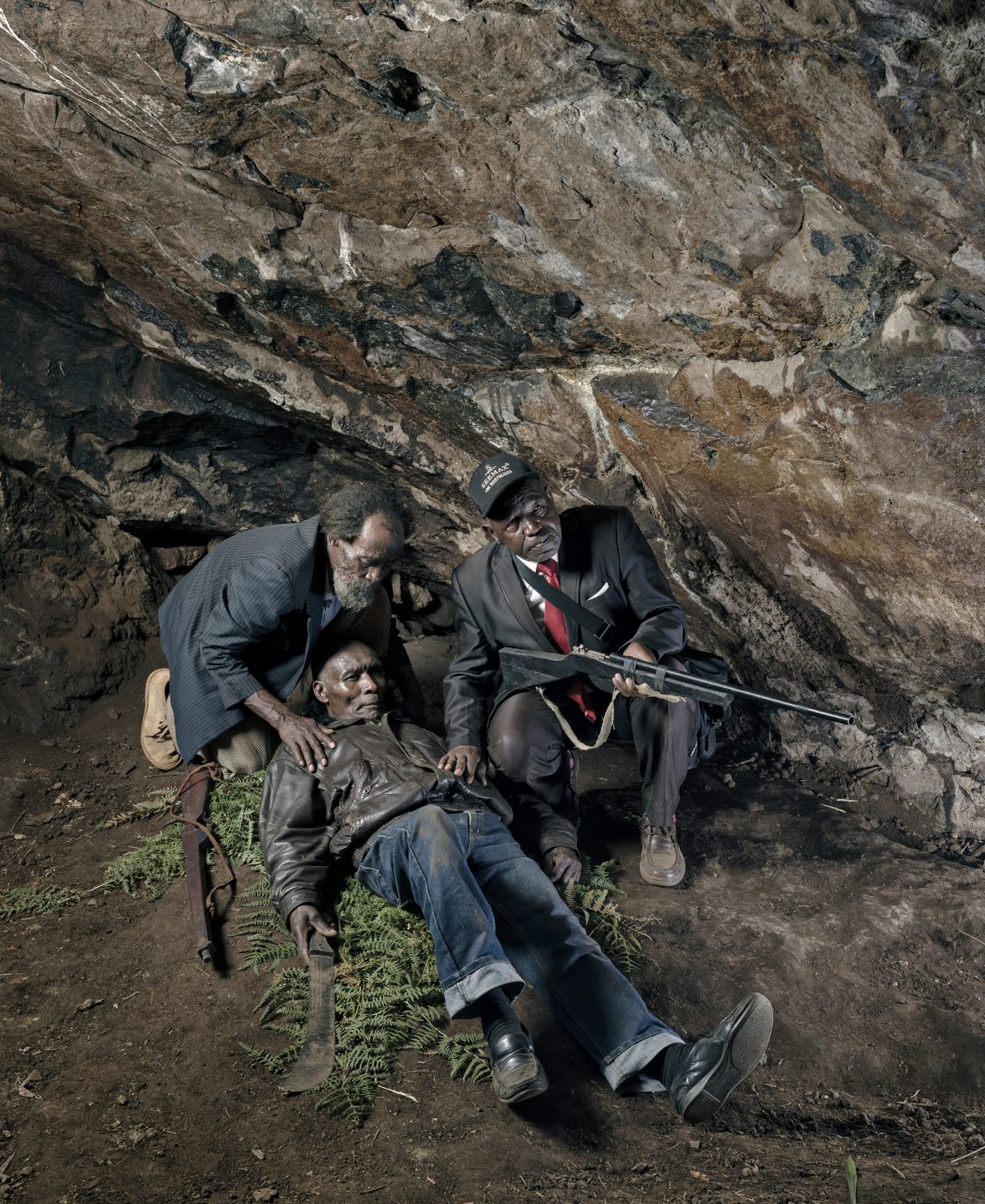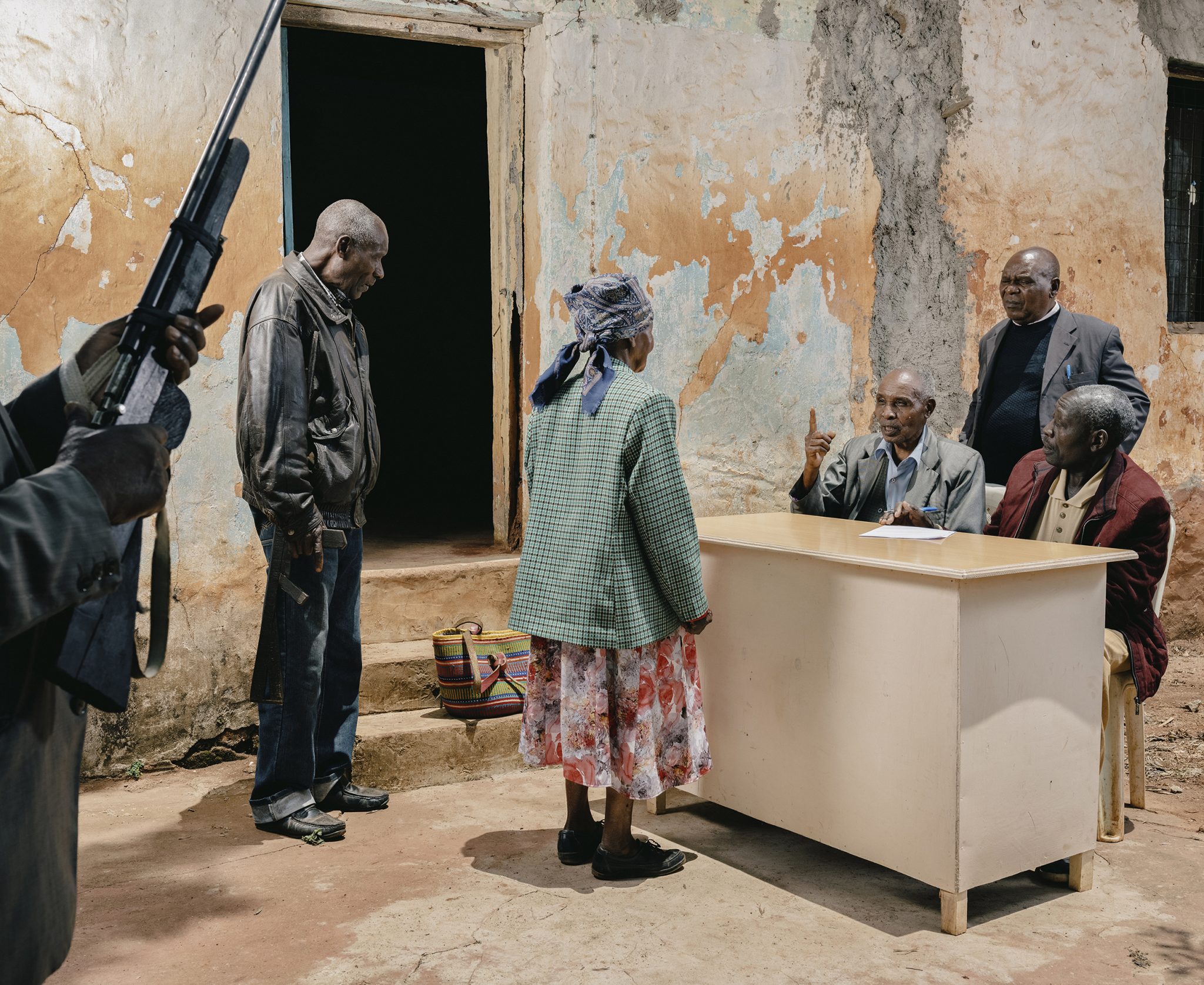How can we weigh present materialities against historical wounds? Zoé Samudzi questions the efficacy of a project to reenact events of the Mau Mau rebellion
Belgian photographer Max Pinckers’s State of Emergency (2024), a self-published photobook responding to Kenya’s colonial history, was released mere months before the nation’s youth took to the streets in June to protest the 2024 Finance Bill, a series of proposed taxes and levies that would have dramatically increased the cost of living for ordinary Kenyans. Protesters were animated by how economic conditions disproportionately impacted Kenya’s young population (the country’s median age is twenty, and the highest unemployment rates were for workers under thirty-five years old) and were further angered by the bill’s neocolonial austerity measures. In an open letter published in June, famed writer Ngugi wa Thiong’o lambasted President William Ruto for allowing Kenya to become a non-member ally of NATO and for visiting the United States, one of the Kenyan government’s major creditors (that the government owes its lenders billions of dollars led, in part, to the austerity bill in the first place). By recounting the US’s ongoing destabilisation of Haiti following enslaved Haitians’ seizure of their independence from the French in 1804, wa Thiong’o laid bare the irony that Ruto would ask the Kenyan people to capitulate to US imperialism, as though they hadn’t resisted British settler colonialism less than 75 years prior.
Wa Thiong’o’s letter deftly connected the present Kenyan condition to the legacy of the 1952 rebellion of the Kenya Land and Freedom Army, more commonly known as the Mau Mau. Beginning in 1895, British settler colonialism in the East Africa Protectorate, which became the Kenya Colony in 1920, established itself through the mass expropriation of Indigenous land and the enclosure of that land from African residency and use. British colonial theft radicalised, among other peoples, the Kikuyu community, and after decades of nonviolent resistance, the Mau Mau was born of a militant faction of the Kenya African Union and began its armed struggle. The anticolonial uprising was brutally suppressed by British colonial forces using counterinsurgency strategies including imprisonment, torture and forced resettlement. In contrast to the 32 white settler casualties, at least 11,000 Africans were killed, according to conservative British estimations.
Based on a close collaboration over ten years between Pinckers and members of the Mau Mau War Veterans Association (MMWVA), State of Emergency offers visual reenactments, or ‘demonstrations’, of both repression and resistance: the veterans perform vignettes of their experiences, which are juxtaposed against an extended cache of archival photographs and texts documenting British propaganda and colonial policy. The ‘demonstrations’ might illustrate a secret Mau Mau oathing ceremony or cadres carrying a wounded fighter through the forest, as well as the torture and executions inflicted by colonial authorities through, for instance, the use of mobile gallows. One striking image shows a besuited veteran in a handstand with his feet up against wall: this, the caption tells us, is the position male detainees assumed when they were to be castrated. In addition to monuments and documentations of the ruins of colonial infrastructure, the photos include contemporary portraits of the legendary fighter Field Marshal Muthoni wa Kirima (who died last year at the age of ninety-two) and other veterans, demystifying the legendary faceless Mau Mau fighters as remembering elders.
At the 2024 Arles Photo Festival, Pinckers received a special mention for the Photo-Text Book Award. At a glance, State of Emergency presents as a laudable history of the Mau Mau uprising: a potential history, a history that wholly rejects what theorist Ariella Aïsha Azoulay has described as ‘imperialism’s conceptual apparatus’. Pinckers, a co-initiator of the School of Speculative Documentary, seeks to subvert the imperial gaze and forensic impulses of mainstream documentary photography in his photographic approach, conjoining hegemonic and insurgent truth(s), highlighting the tacit choreographies of staging in the documentary genre and prioritising collaboration and exchange. In short, Pinckers creates images that compel us to question what it means to be a reliable narrator. How could this critical approach go wrong?

The images in State of Emergency utilise the same visual grammars as Pinckers’s previous works. Through a theatricality, which deliberately accentuates the orchestration of the ‘real’ image, Pinckers reiterates Western stereotypes of non-Western subjects, such as the Thai kathoey he depicted in Lotus (2011) and the Yakuza and salarymen in Two Kinds of Memory and Memory Itself (2015). Applying this rationale to the Mau Mau veterans acting out their own abjection, however, calls into question the veracity of the photographic demonstration rather than the violent imperial archive. A particularly revealing moment is Pinckers’s caption for his photograph of Beninah Wanjugu Kamujeru from MMWVA ‘demonstrating’ her interrogation by a screening team from the Kenyan police. Even as Pinckers holds Kamujeru as a reliable narrator, he notes on the following page – which shows a mirroring 1957 archival image of two suspected female Mau Mau associates surrendering to African colonial agents – that: ‘I encountered this photo at The National Archives in London in 2021, two years after working with Beninah in Murang’a on the scene in which she demonstrates how she was interrogated… I was struck by the resemblance and accuracy of the demonstration. The members of the MMWVA in Murang’a were not aware of this photograph when they planned the scene [italics mine].’
The sharpness (or to use Pinckers’s forensic description, ‘accuracy’) of Kamujeru’s memory is hardly a surprise considering the general lucidity of elders’ recollections, the still seeping wounds of dispossession and the persistence with which stories of struggle are culturally reiterated and intergenerationally circulated. This caption makes evident that Pinckers’s epistemic starting point was the British archive, and indeed, it was a 2014 encounter with a trove of previously suppressed files belonging to the colonial administration that sparked the State of Emergency project. But if we take seriously his insistence that the veterans decided what scenes to recreate, why would these photographic ‘demonstrations’ of actual events be created identically to his other works? And why would he recapitulate and foreground the British narrative by positioning the ‘demonstrations’ as rebuttals against his archival roundups of imperial panics about a wanton and ‘terroristic’ native insurgency or corroborations of the archive’s reluctant admissions of torture?

Despite his stated aims, Pinckers, in practice, perpetuates a sense of incuriosity about the African present and relies on a narrative approach that favours constant reference to the European archive rather than a fluid multi-directionality in which the violences of the past are readily made visible beyond the bodies of its still-living victims. In one photograph, her back to the camera, Susan Nyareri faces land ‘overlooking the mass grave site where she buried her two children while she was detained in an Emergency Village’. In another, Geoffrey Nderitu holds the bones of Mau Mau fighters buried on his land. He describes the relationship between his fruit trees and the soil containing the mass graves of fighters, explaining that he sometimes digs up the bones to show community members when teaching them about the sacrifices of their ancestors. Unsurprisingly, the images in State of Emergency that are most moving are not demonstrations of spectacular British brutality, but those that reference the relationship between the veterans and the land, whether previously lost or not returned to them by the Kenyan government after independence. Although land was the central concern of the Mau Mau’s struggle, it is merely a feature of Pinckers’s project. This feels like a deep political betrayal, as land remains the beating, broken heart underpinning every single remark of loss and longing. There is, frankly, a failure of artistic care enmeshed in a dearth of political imagination in the belief that it is possible to ‘create new “imagined records”’ when the speculative gesture is constantly shunted into the same epistemic frame as the existing ones.
The photo of Susan Nyareri is a simple, heartrending image of mourning and stillness, as well as a lost opportunity to offer a glimpse into the mind of someone grappling with the traumatic aftermath of internment, marked by the death of her children. Geoffrey Nderitu’s consideration of the deceased fighters as his friends and brothers evokes the intimacies between the living, the ancestral dead and the native lands upon which they are (or are not) buried. Without erasing the agency of the participating veterans and their decades-long desire for reputational vindication, such weighty images simply become a part of the oppositional chorus within Pinckers’s ethnographic opus of demonstration. Yet even as the veterans take centre stage, the hyper reliance on the colonial archive ensures I still know almost nothing about them.
There is also a deeper ambivalence to the longue durée of suffering from, first, the British, and then the successive Kenyan government that State of Emergency seldom engages. It asserts itself, despite Pinckers’s oversight, in a two-page portrait of two elderly men, James Wachira Wambugu and Nehemiah Kirenga Muchinji, seated in a boat on the Chinga Dam. This is their first time on a boat, and the first time in the dam’s waters since they were forced to construct it, in 1954, as concentration camp labourers. They lamented how the dam, once a stream that irrigated their farms, was blocked by the British and the land stolen without compensation, while celebrating it as a success and ‘asset to the local community’.

How does one begin to weigh present materialities against historical wounds? Dissonances such as these within postcolonial states give rise to the bald political hypocrisies Kenya’s youth revealed in their protests this summer. They are also illustrated in the fact that part of the historical mythos of the decolonial struggle has been doctored by the complementary propagandas of British colonialism and the rebuke of the Mau Mau by early leaders of postcolonial Kenya. Even though the Mau Mau uprising was crucial in the actualisation of Kenyan independence in 1963, and while early leaders reconstituted the history of liberation struggle into what historian Terence Ranger calls ‘patriotic history’, the militants were demonised by Kenyan presidents Jomo Kenyatta and Daniel arap Moi as nonstate actors akin to terrorists. While Kenyatta had been a former political prisoner and participant in Kikuyu organising, he described the Mau Mau as a ‘terrible disease’ after independence and sent Kenyan security forces to fight against Mau Mau holdouts who believed that the postindependence government had abandoned the land question central to their struggle.
In an aesthetic landscape that seeks to intervene in a truth-abnegating imperial archive, Pinckers’s approach begs an understated question: how does a focus on violent European colonial documentations lead to a failure to implicate the postcolonial African states responsible for perpetuating these centuries of dispossession in the present? How do we enable epistemic violence and foreclosures by failing to pointedly implicate the successor states?
Before embarking on an archival project about Africa (or any non-Western place) such as this one, artistic projects always select a temporal starting point. But artists must consciously choose whether to proceed from and dwell in the colonial truth to present a historical-aesthetic challenge, or whether to altogether refuse its validity as a truth and instead proceed from a more challenging and fruitful political elsewhere.
Zoé Samudzi is a writer and associate editor of Parapraxis Magazine
